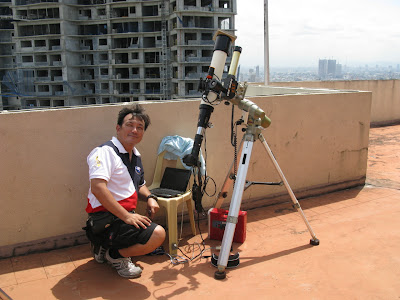Despite the unusually thick haze, we were able to continue documenting the event. The equatorial mount helped a lot to lessen the burden of trying to center the Sun on the camera screen. As the transit progresses, clouds and haze continue to hamper us until we reach the greatest transit time more or less around 9:30am! Greatest transit time refers to the time when Venus is halfway between Ingress I (First Contact) and Egress IV (4th Contact). During this time, some commotions over at Edgar's scope as all were looking through his sharp views of the Venus transit and some of us specially Berenice, Andrew and Edgar were also able to use their Iphone to capture the view with very sharp images!
With Venus needing around 7 hours to cross the Sun's disk, all of us were hungry and thirsty as well! The group would also like to thank fellow ALPer and host Alberto Lao for treating us for some delicious lunch packs as well as drinks! Thank you Albert for your generosity ! From then on, it was almost 90% clear all the way till the last view of Venus' disk totally disappeared to the Northwest limb. I also got a call from fellow ALPer Alex Loinaz who was stationed in PAGASA observatory in UP Diliman telling me if I notice Venus motion across the disk was like an E path as it seems he said "Venus is moving back to where it has started!" Fellow ALPer Berenice also noticed it but I had to explained to them the effect of this unusual effect was caused by the fact that they were observing and imaging the event through an altazimuth mount particularly a photo tripod. With the Sun passing meridian, the Sun's orientation would have rotated slightly back and forth during the time it is crossing near the meridian time. Andrew had to ask his sister Berenice to remove his camera from the tripod and ask here to follow the Sun handheld and the myth is busted :) LOL Everyone had a good laugh and also the newbies got to learn something new from the veterans of the group :) The strange E shaped movement of Venus can be eliminated when one is observing through an equatorial mounted camera or scope. Below composite image I made of the Venus transit could well help break this myth :)
During this time, our telescopes were almost near zenith and I had to lay down almost on the hot concrete floor just to get some shots as we approach Egress III. Because the floor has red paint, I had to removed my dearest ALP uniform before I lay on the floor so as not to stain my uniform :) LOL Despite the heated floor, I persevere and was treated with good shots of the Egress :) Egress III was recorded more or less around 12:30:12pm. A small hint of black drop effect can also be seen but not as pronounced as that of the one after Ingress II because of better sky condition, Egress IV was recorded at 12:47:34pm. Also worth mentioning is the fact 5 minutes before Egress starts, our telescope mount were asking for a telescope reversal so as not to let the telescope hit the tripod, but I had to ignore it because no more time to reverse the mount and recenter it again! So after Egress, I only got a few millimeter left before my camera hits the tripod leg :) LOL ALPer and Treasurer Andrew Ian Chan fondly call this moment "Near 5th Contact!!!" :) LOL
Overall, it was a success on the ALP Venus Transit Binondo Team as we were able to capture the entire event from Ingress to Egress! I later heard from fellow ALPer and VP Jett Aguilar who was stationed at his observatory in Marikina was not able to capture Egress because of heavy downpour during that time and only stopped after the end of Egress :( As for the ALP Luneta team, they lost Ingress because of thick haze as well as former Miss Philippines Venus Raj's appearance at the scope of ALPer and PRO Armando Lee hence wasn't able to timed the event :( But they were able to record the Egress successfully though. Overall, I could say the ALP observation and documentation of this rare event is an OVERALL SUCCESS!!!
Below are the Venus transit's composite and individual images of Ingress, Black Drop Effect, Greatest Transit Time and Egress in Chronological order.
Venus Transit Composite Image

Venus Transit Composite Color Image

Ingress I (Ingress II Exterior) Progression

Ingress II (Ingress Interior)

Black Drop Effect After Ingress II (Ingress Interior)

Venus Transit at Greatest Transit Time

Venus Transit in Ha wavelength

Venus Transit in Ha wavelength

Egress III (Egress Interior)

Black Drop Effect During Egress III

Midway Between Egress III and IV (Egress Exterior)

Egress III (Egress Interior)Progression

Egress IV (Egress Exterior)Progression

Egress IV (Egress Exterior)

Below are some activity shots I took during the event.
Me beside my Venus Transit Imaging Setup - Canon EOS 500D on TV-101 refractor with ATK-1HS II webcam on Coronado PST-Ha on GP-DX mount.

I gotta wear Solar Shades !!! Cool!

I'm practically almost lying on the ground to image the Venus Transit at Egress Times

ALPer Andrew Ian Chan and Iah Serna beside Andrew's Skywatcher 80ED refractor on GP mount

ALPer Edgar Ang beside his Orion XT6 Newtonian reflector on Celestron CG5-GT mount.

ALPer Albert Lao beside his Sony A700 on Sony 500mm f/8 mirror lens.

ALPer Berenice Viola Chan beside his Canon EOS 500D on Canon EF 18-200mm lens.

My Venus Transit setup's position after the conclusion of the Venus Transit event!

A few minutes before undergoing "5th Contact!" - Crashing the camera into the Scope Tripod! :) LOL

ALP Venus Transit Binondo Team

SUCCESS !!!




No comments:
Post a Comment